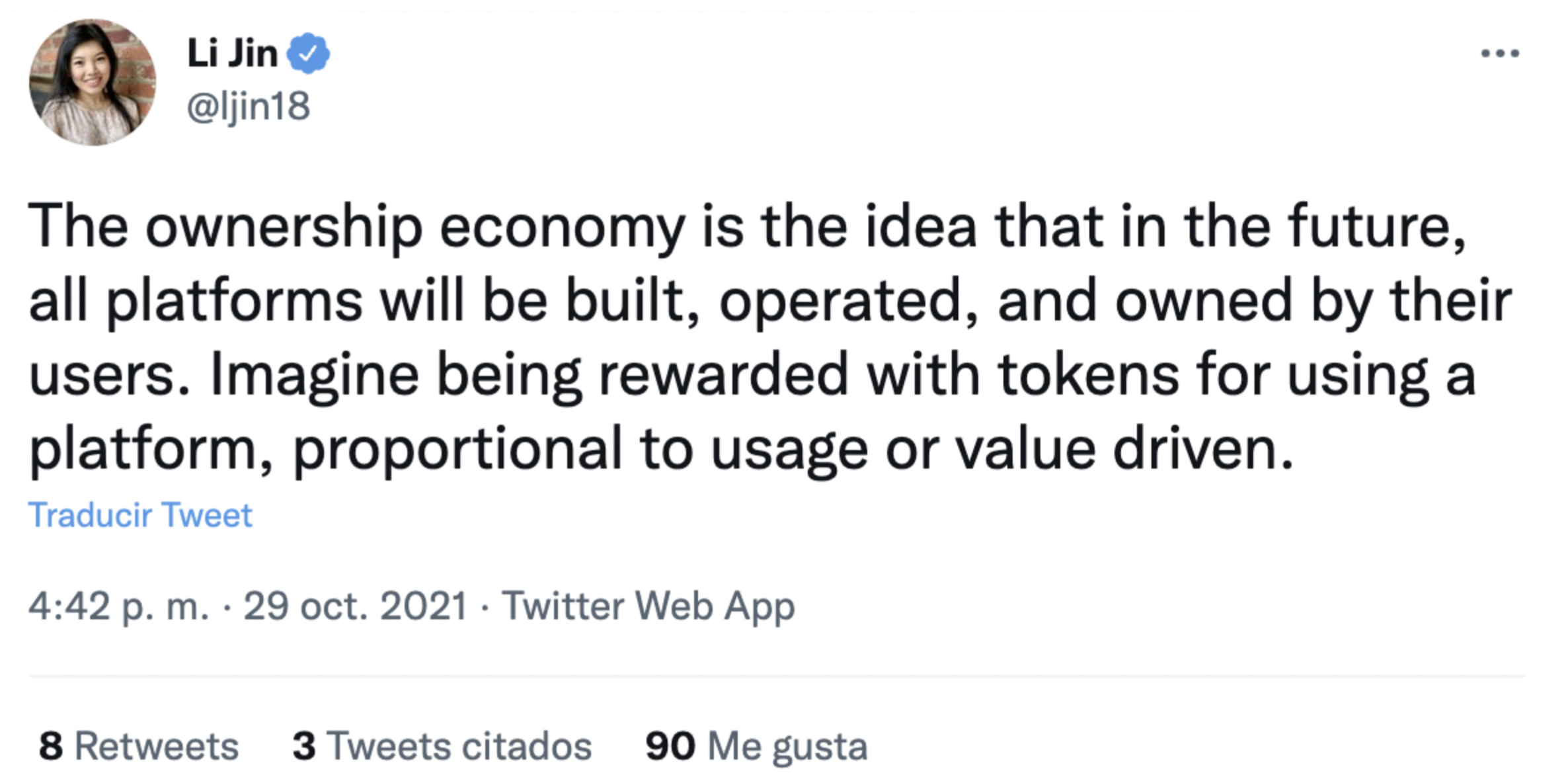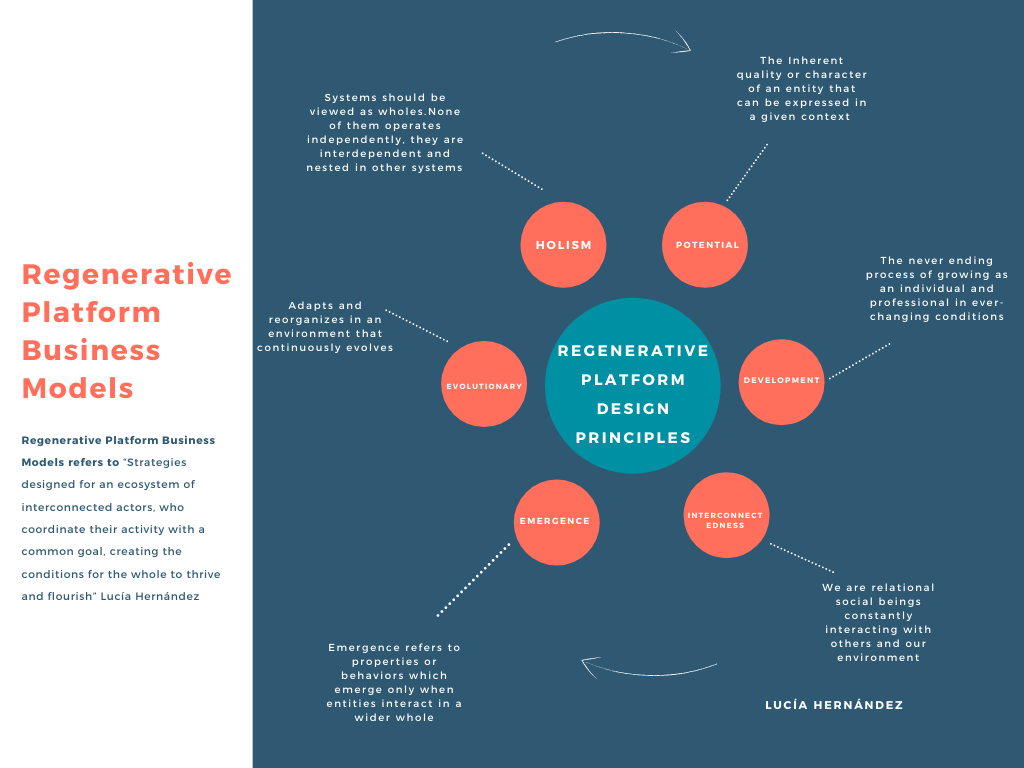Regenerative Platform Design Principles
A framework to design regenerative platform business models.
As I anticipated in this first article, my intention with this work is to provide a framework for designing regenerative platforms for those who have a platform and want to understand how to become regenerative and those who have a traditional regenerative business model and want to become a platform.
If p2p platforms did something remarkable when they appeared was to include the citizen as a producer of value, limited to enterprises until that moment, allowing them to connect directly with others peers, creating value, eliminating intermediaries and evolving to currently become more and more complex.
Some of them don’t even consider themselves intermediaries but instead bulletin boards to avoid liabilities related to the law, labour requirements, and possible consumer claims.
In Europe, until that moment platforms were under the umbrella of the Digital Single Market Strategy, limiting regulation from 2015 updated in December 2020, to regulate their responsibility and imposing new obligations regarding content moderation, due diligence for illegal content and transparency of advertising.
Platforms — like other technologies — are not good or bad, they are what their owners want them to be and what they serve for. What its mission is.
They are very powerful value creation coordination models that, used well, can generate a distributed and major positive impact thanks to network effects.
What if we use their network effect nature to help regenerate our closer ecosystems and beyond, in the market we are involved?
You can find some examples in change.org, giving agency to individuals to propose and support causes that can change laws. Blablacar brings people to places where traditional transport does not arrive communicating isolated places. Som Energia is a non-profit green energy producer-consumer cooperative leveraging in a network, or The Food Assembly putting in contact farmers with end consumers directly, with 1.500 Food Assemblies and 10.000 producers, that control price and production on their own, empowering local consumption and ecolabels.

On the side of companies that are betting on regenerative design, we have well-known Patagonia, Timberland, North Face, Ben & Jerry or Danone, and the last two, B-Corp, working with their value networks to develop and promote regenerative models of agriculture that protect soils, empower farmers and promote animal welfare.
There is also a multitude of small projects that are embracing regenerative practices, a critical step in fighting against extractive practices, inequality and climate change impacts.
To understand the confluences between Regenerative Design and Platform Design, I studied some of the regenerative design principles proposed by a diversity of actors. Among them, I dived into the ones from John Fullerton, founder of Capital Institute, Bill Reed from Regenesis group, thought leader in the field, Janine Benyus, founder of Biomimicry Institute -one of the most important voices in a new wave of designers and engineers inspired by nature- Jenny Andersson founder of ReallyRegenerative a regenerative practitioner and creative strategist with deep knowledge on regeneration, and nRhythm and its Regenerative Framework, a certification I got early this year, which takes a holistic, living systems-based approach to organizational design and management, besides products and services that — I totally recommend.
In general, their approaches are very similar, based always on living systems behaviours, with some small differences. By studying them, one thing that was clear to me is that regenerative design adds a living tissue to the old fashioned company’s machine vision and most importantly, a la layer of intention, and this is not vain.
Entencioun in Latin means “purpose, design, aim or object; will wish, desire, that which is intended,” composed by: In-=Inland, tentus=extended and -tion=action and effect.
An inside-outside continuous loop of cause and effect awareness, feedback, learning and iteration.
On the other hand, what platforms add, among other things, is the tool and the mindset to coordinate networked value creation, «intentionally» designed to empower connections and generate trust, without trust, there are no interactions.
Regenerative Platforms definition
Mixing the best of both worlds I came up with this definition of Regenerative Platforms.
«Strategies designed for an ecosystem of interconnected actors, who coordinate their activity with a common goal, creating the conditions for the whole to thrive and flourish»
Principles
Studying the different proposals I took the ones that, in my opinion, were building the foundations of the regenerative mindset, 6 principles that compose so much wisdom in themselves, that I thank those who made them accessible before me. I combined and extracted the essence of all of them. With humility.
I had the opportunity of validating the way some platforms act and how they approach the following principles in the course of some interviews.
These principles work together: you let the potential flourish allowing emergence, you nurture development gardening self-organized relationships and clearing the way for the whole to flow, being contextual and nested evolves actively listening to the environment, intervening where appropriate, with a holistic point of view.
Let’s dive deep into how regenerative platform design principles fit with platform strategies and how we can improve the approach.
Potential
Potential refers to the Inherent quality or character of an entity that can be expressed in a given context.
The true potential exists before it is manifested.
Creating the space for the entities involved to express all their unique infinite potential, helps the entire ecosystem flourish — platforms are very good at that — since their business model are based on the diversity of those who compose it, producers offering their unique products and services looking for consumers that appreciate it.
We, as consumers, look for personalized items that answer our particular needs in time and place. Beyond the most convenient use of platforms, they are opening a door to everyone to participate in a defined market, in every sector and topic.
At that moment they depend mostly on established platforms standards but technology is evolving at an extraordinary speed that is already allowing us to run our own business in our own way, scaling direct relationships and ownership.

Development
The never-ending process of growing as an individual and professional in ever-changing conditions.
What would be better than learning and evolving in this fluid world? Do It with others. Platforms are hotbeds of learning and evolution, those that promote it by building communities around them will succeed.
Etsy, the handmade and vintage platform bought the social selling second-hand-marketplace Italian Depop for her Gen Z-strong community, inspired by the culture behind it.
“They come for the clothes, but stay for the culture.” — Maria Raga Depop CEO.
Communities are arising around the globe based on common goals, values and interests, and of course human connections, DAOs are allowing these communities in creating direct relationships, with no differentiation between producers and consumers, they are all one creating value in the ecosystem, with regenerative-based principles they could be a force for positive impact.
Interconnectedness
We are relational social beings constantly interacting with others and our environment.
Interactions must flow easily through the ramifications of the system, symmetry of information is mandatory, big amounts of data help us to evolve, low barriers of entry, trust, feedback, reputation, diversity,…all of them, characteristics of the platform economy at its best.
Better still if the data belongs to the user as is the case of Salus. coop, a citizen shared-data cooperative that accelerates research and innovation in the health sector, allowing citizens to decide in which projects they want to help with their data.
Relationships may be self-organized and, a distributed and decentralized governance is needed to fit with living systems inner nature. Something that is not yet so common in most of the platforms, except for cooperative platforms and DAO’s, they are still immature but with a high potential for evolution, thanks to technological development and shifts in societal and cultural beliefs.
Emergence
Emergence refers to properties or behaviours which emerge only when entities interact in a wider whole.
It may sound like an easy way but embracing emergence means leaving control, which sometimes is not an easy task.
But the reward is enormous because the best things emerge from people in co-creation, interacting with others and their environment.
New products and services, new verticals, new ideas, innovation in its purest form.
And there would be no evolution without emergence, which leads me to speak of the following principle.
Evolutionary
Adapts and reorganizes in an environment that continuously evolves.
Regenerative platforms evolve and change through their interactions, keeping a flexible and creative behaviour that communicates within the other parts of the system leading to a more adaptive and resilient ecosystem, one that is permeable to the changes at the different levels of the system, is aware, self-organizes and self-creates accordingly, in an autopoietic way.
At a macro level, we are seeing an evolution of tools that allow decentralized value creation and ownership responding to conjunctural shifts — climate change awareness, unemployment rise, the boredom of dependent relationships, independent workers increment, broken value chains, etc — from a micro point of view products and services provided by platforms evolve answering user demands and needs.
Holism
Systems should be viewed as a whole. None of them operates independently, they are interdependent and nested in other systems.
Any positive or negative action immediately impacts the rest of the system, amplifying or diversifying its effects.
This principle is probably the most uncommon as far as business is concerned but also disciplines. Not counting B-Corps and similar that have more contextual approaches.
In an industrial world of standardized products and tasks, the context was largely irrelevant, a distraction. In the regenerative platform-age context is becoming more and more central to value creation. If we don’t pay attention to the circumstances surrounding a person, place or event, we are unlikely to understand how to create the greatest personalized value for each of them.
This is one of the pending issues for most public and private organizations.
This is a summary of the 6 principles we can apply by design when building regenerative platform business models.
Each of these principles in collaboration can serve as a guide to define models that, by design, aid regeneration, although the most important thing is undoubtedly the intention with which we apply them. Every action counts, every day, every city, every organization and every individual have a role to play.

— —
The world is evolving rapidly the same way as our thinking and actions need to do it, regenerating our social, natural and business ecosystems is key, technology can help us to connect in ways we never thought before and scale the positive impact while being profitable and more efficient in every way.
“Whenever we have made a decision for the good of the planet it has become good for Ecoalf like a boomerang” — Javier Goyaneche Founder and President of ECOALF at Ship2B Impact Forum
Happy to discuss these regenerative platform design principles, comment, and learn from your thoughts while this thinking evolves and is applied.

This blog post is right on point. I totally agree with your views and find them well-articulated. Keep up the good work!